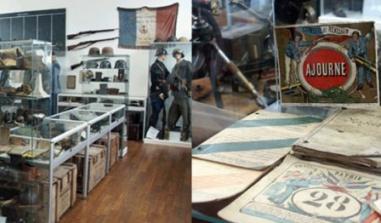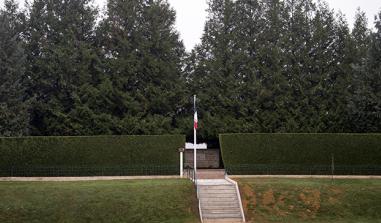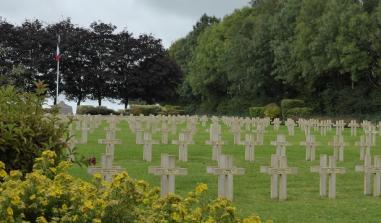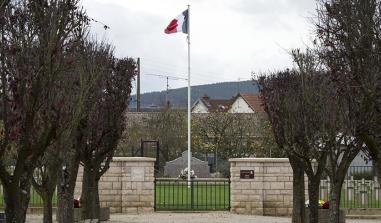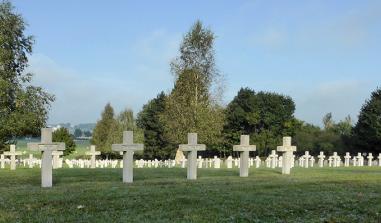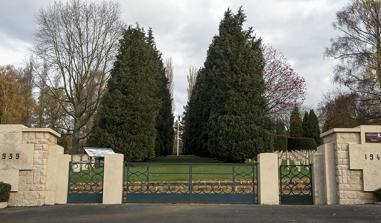Bazeilles
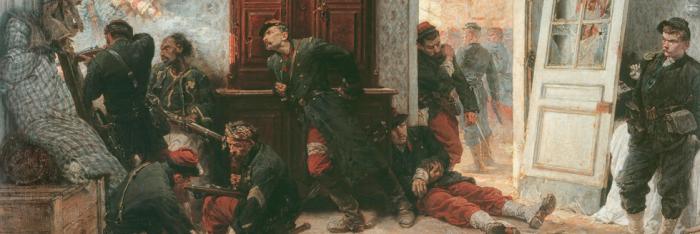
The Last Cartridge, from the painting by Alphonse de Neuville. ©Musée de la dernière cartouche
The museum at the House of the Last Cartridge is one of the most striking sites recalling the war of 1870. The famous painting "The Last Cartridge", by artist Alphonse de Neuville is displayed here.
The House of the Last Cartridge "Thanks principally to the actions of Captain Aubert, the house was quickly readied as a last line of defence; taking a rifle, this brave officer positioned himself by one of the windows, and thanks to his wonderful example, his men kept their heads and followed his lead.
However, despite suffering heavy losses, the enemy continued to advance. Seeing that our house was about to be surrounded and being unable to walk, I tried to persuade the officers who were with me to leave me with a few men and to withdraw the majority of the division. Not a single one agreed and they all declared that they would remain with me to defend to the end... After two hours we were completely surrounded by the 15th Bavarian Regiment.
Our house was soon in a most piteous state; gaping holes in the doors and windows; our roof was half taken off by a shell that wounded four or five men. Despite this, the fight continued relentlessly. It only ended when our ammunition ran out." Commandant LAMBERT, Rapport sur la bataille de Bazeilles ("Report on the Battle of Bazeilles"), in HABENECK Charles, Martyr Regiments, Paris, Pagnerre, 1871.
The museum at the House of the Last Cartridge is one of the most striking sites commemorating the war of 1870; it recalls the two days of fighting between the two brigades of General de Vassoigne's Blue Division of Marines and the Bavarian soldiers commanded by General Von der Tann. The battle got properly underway around noon on 31st August when General Martin de Pallières's second brigade received the order to retake the strategically important village of Bazeilles, which had just fallen into enemy hands. After a day of fierce fighting and thanks to the reinforcements from General Reboul's 1st Brigade, which arrived around 4pm, the village was completely retaken by nightfall. But at dawn on 1st September, General Von Der Tann's soldiers attacked Bazeilles once again. Despite many assaults that enabled the enemy to be driven back several times, at the end of the morning the Marine Division - overwhelmed by the Bavarian numerical advantage and firepower - was forced to retreat towards Sedan. It was at this time that the episode known as the House of the Last Cartridge took place.
In a burnt out village, destroyed by artillery fire from the day before, around thirty officers, NCOs and men from the Marine infantry took cover, alongside Commandant Lambert, in the modest two-storey inn belonging to the Bourgerie family - the last house in the village of Bazeilles on the road to Sedan. Here, for almost four hours, they put up fierce resistance to the Bavarian troops. At last surrounded and out of ammunition, in mid-afternoon Captain Aubert fired the last cartridge from the window of the master bedroom on the first floor. A white handkerchief tied to a rifle then announced the marsouins' surrender with Commandant Lambert, wounded in the foot, the first to leave the house. Throughout the hours of the battle, the Marine Division lost 2,700 men including around a hundred officers.
The Bavarian soldiers lost more than twice that number; the day after the fighting they began a series of horrifying reprisals against the population of Bazeilles, some of whom had taken the side of the Marine Troops; the village was set on fire, with some inhabitants shot, burned alive or arrested and deported. Civilian victims from the village numbered more than forty. For this heroic resistance, Bazeilles was awarded the Légion d'honneur in 1900, an emblem still found today on the town's crest, alongside the anchor of the marine troops and a house in flames. Following the defeat, the town also became an important site of remembrance and pilgrimage. Thus, on 19th March 1875, the Courrier des Ardennes published an article in which a museum in Bazeilles was announced: "Mr Bourgerie and his son, along with others, have collected a considerable number of objects, which together form an extremely interesting museum. Objects were exhibited in one of the ground floor rooms of the house. In May of the same year, General de Vassoigne visited the ruins of the House of the Last Cartridge and an initial monument was erected there in November opposite the church. But the first major ceremony took place on 31st August 1895, 25 years after the events, attended by the former Commandant Lambert, who by then was a General.
But it wasn't until 1899 that Arthur MEYER, director of Le Gaulois newspaper, launched a public appeal to finance the purchase of the house in order to "convert it into a modest museum dedicated to the memory of the heroes who died there". On 1st August 1909, the paper finally handed it over to the French heritage organisation Le Souvenir Français. Nevertheless, it was not until 3rd September 1950 that the first national commemoration of the fighting of 1870 was held. That same year, with the agreement of le Souvenir Français, the upkeep, administration and management of the Bazeilles museum was placed in the hands of National Committee for the traditions of the Marines, which also owns museum collections. To this task was added the management of the ossuary, built between 1876 and 1878 a hundred or so metres from the museum that contains the remains of 3,000 German and French soldiers
The House of the Last Cartridge, which receives 2,000 visitors a year on average, is currently closed, following the decision of the National Committee for the traditions of the Marines to restore it. Part of the work will be to upgrade the facilities and make them safe. The museum-related work carried out by specialists Mostra Conseil, will enable the house to retain its authentic feel and moving character whilst making it more attractive through the use of new technology. On the ground floor, visitors will find a reception area and the first museum exhibition room, called the Lambert room, dedicated to the 1870 war and the role of the Marines in this conflict. On the first floor, the Delay Room presents the Battle of Sedan. But the museum's most significant exhibits will be found in the Aubert and Lambert Rooms. The former will recount the fighting over Bazeilles whilst the latter, including the bedroom from where the final action was fought, will honour the memory of The Last Cartridge. In this room visitors will find Alphonse de Neuville's famous work painted in 1873, entitled "The Last Cartridge". Eventually, the Marines' Museum will form part of the "Remembrance Centre" that the Sedan regional authorities hope to establish in Sedan itself, and which will enable the main remembrance sites of the area to form a network.
The issue of accepting disabled people was studied and partly resolved by the construction of a specially adapted toilet block. However, those in wheelchairs are unable to visit the first floor. To allow them to do so would have involved demolishing the house and rebuilding it around a specially adapted staircase. Eventually, the Marines' Museum will form part of the "Remembrance Centre" that the Sedan regional authorities hope to establish in Sedan itself, and which will enable the main remembrance sites of the area to form a network.
Nota (1) - This division, composed of the four infantry regiments (1, 2, 3 and 4) and the 1st Marine artillery regiment, had originally been assembled with a view to carrying out a deception manoeuvre in the Baltic sea. The disasters suffered in the Alsace and in Lorraine during the initial battles forced the French high command to regroup its available forces at the camp at Chalons sur Marne in order to lend a hand to its Eastern army (Bazaine) trapped in Metz. Christened the "Blue Division" because of the colour of their uniforms, it was part of the 12th Army Corps (General Lebrun), making up its 3rd division (the two others, having been hastily cobbled together from staff picked up in warehouses and enlisted or conscripted young people, did not constitute solid units). It comprised of soldiers, the majority of whom were enlisted and experienced and had undergone severe training in distant campaigns and were already hardened. Its officers had earned their stripes under fire and the upper ranks had acquired sound fighting experience. The civilian population was well aware of this, giving them a warm welcome wherever they went.
La Maison de la dernière Cartouche
12 rue Dernière Cartouche - 08140 Bazeilles
Tel: 03 24 27 15 86
http://musees-de-france-champagne-ardenne.culture.fr/musee_bazeilles.html
A tableau of a heroic episode during the 1870 war depicting the Marine division known as the "Blue Division" Now completely renovated, the museum tells the story of the battles from the 31st August until the 1st September 1870, with pictures, armour and uniforms of the time.
The museum is closed on Mondays and Tuesdays.
Closed annually from the 20th December until the 15th January.
Museum tours from the 15th June to the 30th September from 10 am to 12 pm and from 1.30 pm until 6 pm
From the 1st October until the 14th June 10 am to 12 pm and from 1.30 pm until 5 pm
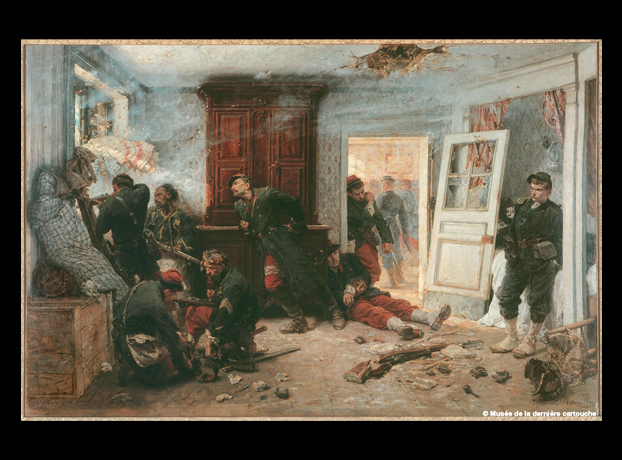
La Dernière Cartouche, d'après le tableau d'Alphonse de Neuville. ©Musée de la dernière cartouche
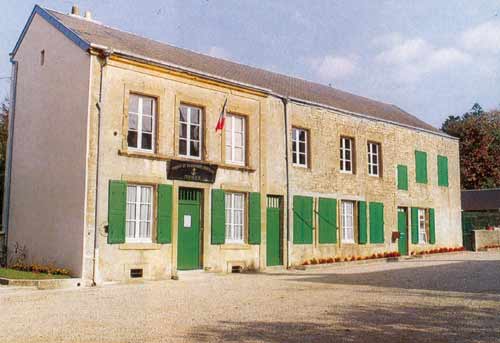
La maison de la dernière cartouche aujourd'hui. Source : Comité national des traditions des troupes de Marine
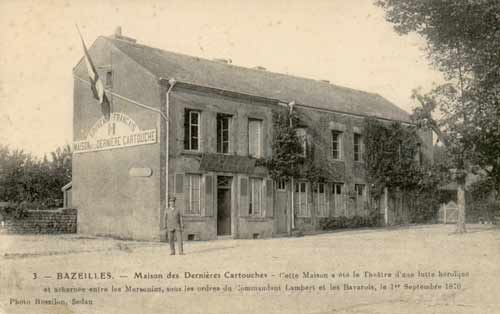
La maison de la dernière cartouche vers 1911. Source : Comité national des traditions des troupes de Marine
Practical information
12 rue Dernière Cartouche 8140
Bazeilles
03 24 27 15 86
Adultes : 3 € Enfants : 1,50 € Militaires et anciens combattants : 1,50 € Groupes adultes: 1,50 € Groupes enfants: 0,50 €
Du 15 juin au 15 septembre : 10h-12h et 13h30-18h Du 15 septembre au 15 juin : 13h30-17h
Fermé le lundi et le mardi. Fermeture annuelle du 15 décembre au 5 janvier


